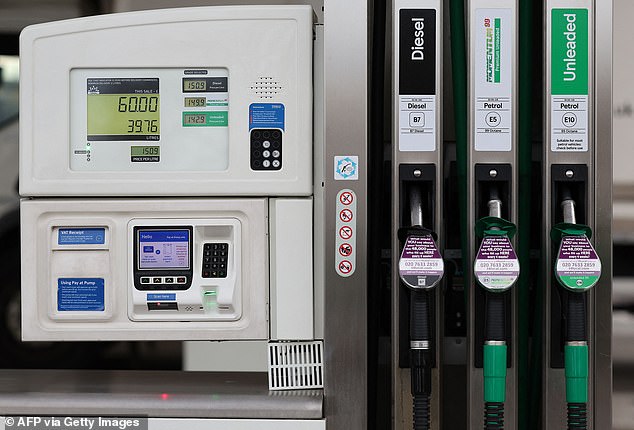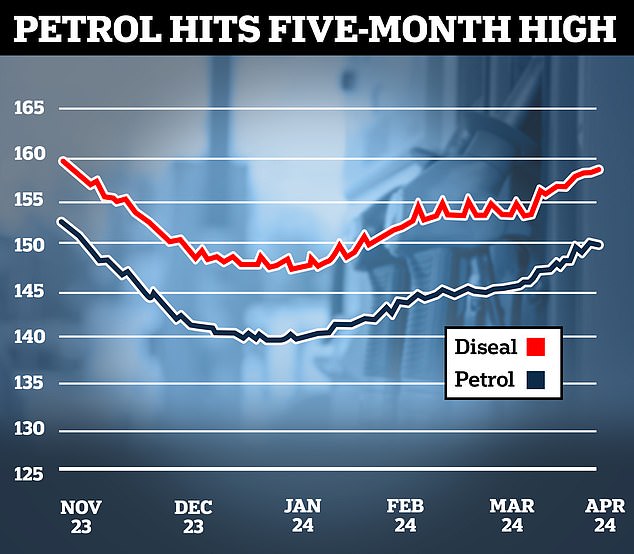Diesel consumption has fallen by almost a billion liters in a year, while the demand for gasoline is skyrocketing
- UK diesel consumption fell by 3.2% in the 2023-2024 financial year
- Diesel is hovering at just under 160 cents per litre, while high prices drive people to petrol
- Gasoline consumption increased by 4.2%, but gasoline cars are less economical
UK diesel consumption has fallen by almost a billion liters in the 2023 to 2024 financial year, new statistics show.
An analysis of HMRC figures released this week showed that Britain used 968 million liters less diesel, while petrol consumption increased by 702 million litres.
The AA attributes this to high diesel costs coinciding with effective anti-diesel campaigns in towns and cities, causing drivers to switch from diesel to petrol, hybrid and electric cars.
An analysis of HMRC figures this week showed that Britain used 968 million liters less diesel, while petrol consumption increased by 702 million litres.
This is evident from the figures of the Hydrocarbon Oil Bulletin for the financial year 2023 to 2024. diesel consumption fell by 3.2 percent from 30.075 billion to 29.107 billion liters.
In contrast, British petrol consumption increased by 4.2 percent year on year, from 16.579 billion to 17.281 billion litres.
The AA believes the decline is likely due to both the price and demonization of diesel in densely populated urban areas.
Diesel remains as much as 20 cents per liter more expensive than gasoline, even after the pump price shocks of 2022 and early 2023 faded.
The rise in fuel costs in recent weeks has been well documented, with average UK diesel costs reaching 158.3 pa liters on April 22, according to AA analysis.
At the time of registration, petrol prices were 150.1 pa-litre, which equates to around 8 pence more per liter for diesel than petrol.
These higher comparative prices are likely responsible for deterring large numbers of diesel car owners and potential buyers.

While the number of petrol cars has plateaued at 19.24 million between the fourth quarter of 2019 and the third quarter of 2023, the number of diesel cars has fallen by 1.5 million over the same period (12,852 versus 11,352).

The fall in petrol pump prices from a peak of 191.5 pa liter in July 2022 to 143.2 pence in July 2023 will also have had an impact, as will other factors such as workers returning to offices and public transport disruptions causing commuters are forced to travel by car.
Furthermore, the AA believes that the anti-diesel mantra in cities and large towns has had an influence on the shift away from diesel.
The latest statistics from the Department for Transport show that while the number of petrol cars reaches a plateau of 19.24 million between the fourth quarter of 2019 and the third quarter of 2023, the number of diesel cars fell by 1.5 million in the same period (12,852 versus 11,352).
Gasoline cars have maintained their numbers, while the combined number of hybrids, electric vehicles (EVs) and other alternative fuel cars has increased.
These low-emission alternatives have increased from 800,000 to almost three million in the same period as the number of diesel engines has fallen.
Now that diesel owners have switched to petrol, more petrol will have been used for the same journeys, as diesel cars are usually about 15 to 20 percent more efficient than petrol.
Luke Bosdet, the AA’s road fuel spokesman, said: ‘This week’s UK fuel economy statistics appear to reinforce the view that diesel cars’ days are numbered. The big question is how many of their former owners have switched to electric cars or hybrids?
‘However, it would be wrong to write off the diesel car now. As the price difference at the pump between petrol and diesel narrows significantly and over a long period of time, there are types of driving styles and journeys where DERV’s superior fuel efficiency shines.
‘While cities and built-up areas may try to run diesels outside the city, on public roads and in rural areas a diesel vehicle can be king.’
